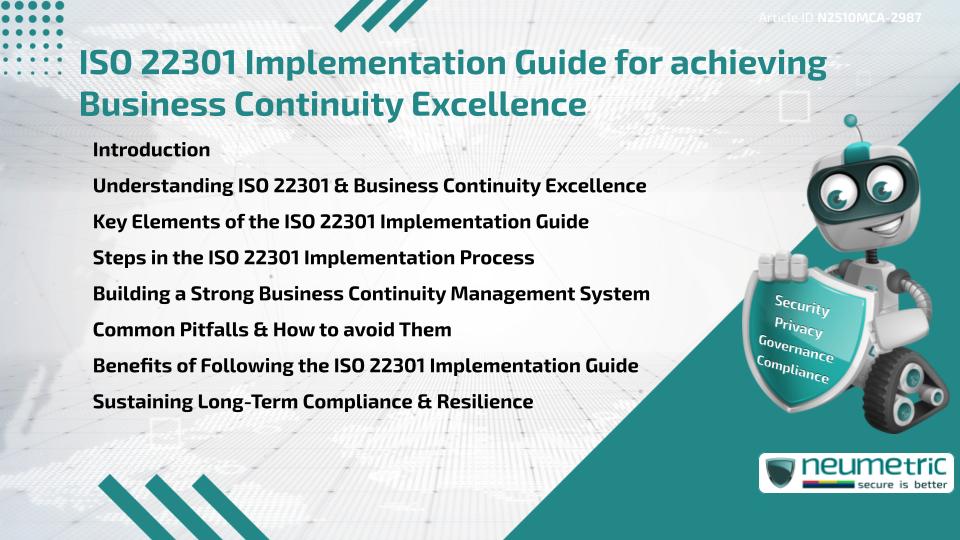Table of Contents
ToggleIntroduction
The ISO 22301 Implementation Guide offers a clear & structured approach for organisations aiming to build Resilience & achieve Business Continuity excellence. ISO 22301 defines the Framework for developing, implementing & maintaining a Business Continuity Management System [BCMS] that prepares organisations for disruptions.
This guide helps businesses design effective continuity strategies, align operations with Global Standards & protect Critical Processes from Potential Threats. Whether it is a natural disaster, cyberattack or supply chain disruption, the ISO 22301 Implementation Guide ensures your organisation stays operational & trusted.
Understanding ISO 22301 & Business Continuity Excellence
ISO 22301 is the international Standard that sets out requirements for a robust BCMS. It focuses on identifying Risks, evaluating their Impact & developing Action Plans to sustain key functions during & after disruptive events.
Business Continuity excellence goes beyond Compliance. It means embedding proactive Risk Management & Crisis Response into an organisation’s culture. By following the ISO 22301 Implementation Guide, companies not only protect assets but also gain Stakeholder confidence through proven Resilience.
Key Elements of the ISO 22301 Implementation Guide
A successful ISO 22301 Implementation Guide covers these essential elements:
- Context & Scope: Define the operational boundaries & objectives of the BCMS.
- Leadership & Commitment: Ensure Top Management provides direction & resources.
- Risk & Impact Assessment: Identify & evaluate Potential Threats to operations.
- Business Continuity Strategies: Develop plans to manage & recover from disruptions.
- Training & Awareness: Educate Employees on their roles during Incidents.
- Performance Evaluation: Measure effectiveness through Audits & Reviews.
These elements form the foundation for building continuity excellence across all business units.
Steps in the ISO 22301 Implementation Process
To effectively implement ISO 22301, organisations can follow a structured process:
- Conduct a Gap Analysis: Compare current practices against ISO 22301 requirements.
- Secure Management Support: Gain Leadership commitment to drive implementation.
- Develop the BCMS Framework: Define Policies, Responsibilities & Key Processes.
- Perform Business Impact Analysis [BIA]: Prioritise critical functions & recovery goals.
- Implement & Test Plans: Execute strategies & conduct scenario-based testing.
- Monitor, Review & Improve: Continuously enhance the BCMS based on feedback.
- Prepare for Certification: Engage with an accredited Certification body.
Building a Strong Business Continuity Management System
An effective BCMS integrates seamlessly into the organisation’s existing structure. It should be part of daily operations rather than a separate function.
Key aspects include clear communication channels, cross-functional collaboration & continual training. Regular exercises & Incident simulations help validate preparedness & identify areas for improvement.
The Business Continuity Institute offers useful resources & templates to strengthen your BCMS Framework.
Common Pitfalls & How to avoid Them
While implementing ISO 22301, organisations often face challenges such as:
- Insufficient Top Management Support: Without Leadership backing, implementation stalls.
- Overcomplicated Documentation: Excessive paperwork can hinder progress.
- Lack of Employee Engagement: Continuity efforts fail if staff are unaware or untrained.
- Ignoring Continuous Improvement: Neglecting reviews & updates weakens resilience.
To overcome these, organisations should keep Documentation simple, foster Awareness & maintain open Feedback Loops.
Benefits of Following the ISO 22301 Implementation Guide
Adopting the ISO 22301 Implementation Guide delivers numerous benefits:
- Enhanced organisational Resilience & Preparedness.
- Reduced operational downtime during disruptions.
- Improved Reputation & Customer confidence.
- Compliance with international Business Continuity Standards.
- Competitive advantage through demonstrated Reliability.
By implementing ISO 22301 effectively, businesses strengthen Trust & Stability across all operations.
Sustaining Long-Term Compliance & Resilience
Maintaining ISO 22301 Compliance is an ongoing process. Organisations should:
- Conduct periodic Audits & Management Reviews.
- Update the BCMS after structural or environmental changes.
- Continue Staff training & Awareness programs.
- Regularly test Recovery & Response Procedures.
Consistency ensures that the ISO 22301 Implementation Guide remains effective & aligned with evolving business needs.
Takeaways
- The ISO 22301 Implementation Guide provides a structured Framework for achieving Business Continuity Excellence.
- It helps organisations identify Risks, protect Key Functions & recover efficiently from Disruptions.
- Leadership commitment & ongoing testing ensure long-term Resilience.
- Certification boosts Confidence, Compliance & Operational Reliability.
- Regular Reviews & Updates keep the BCMS effective & aligned with organisational goals.
FAQ
What is ISO 22301 implementation?
It is the process of establishing & maintaining a Business Continuity Management System [BCMS] based on ISO 22301 Standards.
How long does ISO 22301 implementation take?
Typically between six (6) & twelve (12) months, depending on the organisation’s complexity & readiness.
What are the main steps in ISO 22301 implementation?
They include Gap Analysis, Risk Assessment, Business Impact Analysis, Strategy development & System validation.
Who is responsible for ISO 22301 implementation?
Top Management & Business Continuity teams share responsibility, supported by all Employees.
Can ISO 22301 integrate with other Standards?
Yes, it can align with ISO 9001, ISO 27001 & ISO 45001 for an integrated management approach.
Why is ISO 22301 Certification important?
It proves an organisation’s ability to continue operations during disruptions, enhancing trust & competitiveness.
How often should a BCMS be reviewed?
At least once per year or after significant organisational or environmental changes.
Need help for Security, Privacy, Governance & VAPT?
Neumetric provides organisations the necessary help to achieve their Cybersecurity, Compliance, Governance, Privacy, Certifications & Pentesting needs.
Organisations & Businesses, specifically those which provide SaaS & AI Solutions in the Fintech, BFSI & other regulated sectors, usually need a Cybersecurity Partner for meeting & maintaining the ongoing Security & Privacy needs & requirements of their Enterprise Clients & Privacy conscious Customers.
SOC 2, ISO 27001, ISO 42001, NIST, HIPAA, HECVAT, EU GDPR are some of the Frameworks that are served by Fusion – a SaaS, multimodular, multitenant, centralised, automated, Cybersecurity & Compliance Management system.
Neumetric also provides Expert Services for technical security which covers VAPT for Web Applications, APIs, iOS & Android Mobile Apps, Security Testing for AWS & other Cloud Environments & Cloud Infrastructure & other similar scopes.
Reach out to us by Email or filling out the Contact Form…


